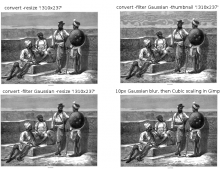We use a lot of historic media, for obvious reasons. Unfortunately, engravings, a very common type, often have large numbers of not-quite-horizontal lines.
This results in bad thumbnailing at times. For example:
http://upload.wikimedia.org/wikipedia/commons/thumb/1/16/Rajpoots_2.png/310px-Rajpoots_2.png
is not a very good thumbnail of http://upload.wikimedia.org/wikipedia/commons/1/16/Rajpoots_2.png
Is there anything that can be done?
Version: unspecified
Severity: normal

